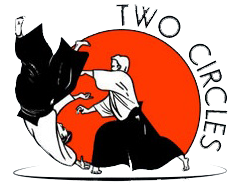Morihei Ueshiba, founder of Aikido
Aikido’s founder, Morihei Ueshiba, was born in Japanon December 14, 1883. As a boy, he often saw local thugs beat up his father for political reasons. He set out to make himself strong so that he could take revenge. He devoted himself to hard physical conditioning and eventually to the practice of martial arts, receiving certificates of mastery in several styles of jujitsu, fencing, and spear fighting. In spite of his impressive physical and martial capabilities, however, he felt very dissatisfied. He began delving into religions in hopes of finding a deeper significance to life, all the while continuing to pursue his studies of budo. By combining his martial training with his religious and political ideologies, he created the modern martial art of aikido. Ueshiba decided on the name “aikido” in 1942 before that he called his martial art “aikibudo”.
On the technical side, aikido is rooted in several styles of jujitsu (from which modern judo is also derived), in particular daitoryu-(aiki)jujitsu, as well as sword and spear fighting arts. Oversimplifying somewhat, we may say that aikido takes the joint locks and throws from jujitsu and combines them with the body movements of sword and spear fighting. However, we must also realize that many aikido techniques are the result of Master Ueshiba’s own innovation.
Initial development history
Ueshiba moved to Hokkaidō in 1912, and began studying under Takeda Sokaku in 1915. His official association with Daitō-ryū continued until 1937. However, during the latter part of that period, Ueshiba had already begun to distance himself from Takeda and the Daitō-ryū. At that time Ueshiba was referring to his martial art as “Aiki Budō”. It is unclear exactly when Ueshiba began using the name “aikido”, but it became the official name of the art in 1942 when the Greater Japan Martial Virtue Society (Dai Nippon Butoku Kai) was engaged in a government sponsored reorganization and centralization of Japanese martial arts.
AI – harmony, KI – spirit, mind, or universal energy, DO – the Way
Those who are not well informed about the true character of Aikido consider it to be nothing more than one of the old-fashioned martial arts.
It is true that Morihei Ueshiba (1883-1969), the Founder of Aikido, studied many different kinds of traditional martial arts, and used that experience to formulate the techniques of Aikido. However, Aikido is far more than a composite of various martial arts. The Founder made that very clear: “Heretofore, I studied many kinds of martial art systems — Yagyu Ryu, Shinyo Ryu, Kito Ryu, Daito Ryu, Shinkage Ryu, and so on — but Aikido is not a composite of those arts. All Aiki techniques are a function of ki.” Nevertheless, Aikido and Daito Ryu Aikijutsu are often confused even in Japanese reference works, and it is easy to understand why the general public cannot easily distinguish between the two arts.
It is a fact that Morihei Ueshiba was once a disciple of Sokaku Takeda (1859- 1943), Grandmaster of the Daito Ryu, but when he was asked by a newspaper reporter if the creation of Aikido was a direct consequence of his training in the Daito Ryu, Morihei replied “No. It is more accurate to say that Master Sokaku opened my eyes to the true nature of Budo.” The essential nature of Aikido is quite different from the other martial arts Aikido is a relatively modern, non-competitive martial art for the development of mind, body and spirit. It was developed by Morihei Ueshiba around 1930 based on his detailed knowledge of several traditional martial arts, most notably Daito Ryu Jujutsu. Aikido is often characterised by its fluid and dynamic movement.


